The Removal of Phosphorus from Wastewater Using a Sewage Sludge Biochar: A Column Study
Abstract
:1. Introduction
2. Materials and Methods
2.1. Characterization of Adsorbents
2.2. Characterization of Wastewater Used for Adsorption Studies
2.3. Experimental Design
3. Results and Discussion
3.1. Surface Area and Porosity
3.2. Results of the Filtration Experiments
4. Conclusions
Author Contributions
Funding
Data Availability Statement
Conflicts of Interest
References
- Geng, H.; Xu, Y.; Zheng, L.; Gong, H.; Dai, L.; Dai, X. An overview of removing heavy metals from sewage sludge: Achievements and perspectives. Environ. Pollut. 2020, 266, 115375. [Google Scholar] [CrossRef] [PubMed]
- Agoro, M.A.; Adeniji, A.O.; Adefisoye, M.A.; Okoh, O.O. Heavy Metals in Wastewater and Sewage Sludge from Selected Municipal Treatment Plants in Eastern Cape Province, South Africa. Water 2020, 12, 2746. [Google Scholar] [CrossRef]
- Wojciula, A.; Boruszko, D.; Pajewska, G. Analysis of Heavy Metal Fraction Content in Sewage Sludge from Selected Wastewater Treatment Plants. J. Ecol. Eng. 2021, 22, 98–105. [Google Scholar] [CrossRef]
- Kowalik, R.; Gawdzik, J.; Bąk-Patyna, P.; Ramiączek, P.; Jurišević, N. Risk Analysis of Heavy Metals Migration from Sewage Sludge of Wastewater Treatment Plants. Int. J. Environ. Res. Public Health 2022, 19, 11829. [Google Scholar] [CrossRef] [PubMed]
- Ali, H.; Khan, E.; Ilahi, I. Environmental Chemistry and Ecotoxicology of Hazardous Heavy Metals: Environmental Persistence, Toxicity, and Bioaccumulation. J. Chem. 2019, 2019, 6730305. [Google Scholar] [CrossRef]
- Seshadri, B.; Bolan, N.S.; Choppala, G.; Kunhikrishnan, A.; Sanderson, P.; Wang, H.; Currie, L.D.; Tsang, D.C.W.; Ok, Y.S.; Kim, G. Potential value of phosphate compounds in enhancing immobilization and reducing bioavailability of mixed heavy metal contaminants in shooting range soil. Chemosphere 2017, 184, 197–206. [Google Scholar] [CrossRef] [PubMed]
- Andrunik, M.; Wołowiec, M.; Wojnarski, D.; Zelek-Pogudz, S.; Bajda, T. Transformation of Pb, Cd, and Zn Minerals Using Phosphates. Minerals 2020, 10, 342. [Google Scholar] [CrossRef]
- Comber, S.; Gardner, M.; Darmovzalova, J.; Ellor, B. Determination of the forms and stability of phosphorus in wastewater effluent from a variety of treatment processes. J. Environ. Chem. Eng. 2015, 3, 2924–2930. [Google Scholar] [CrossRef]
- Zhang, Y.; Yang, K.; Fang, Y.; Ding, J.; Zhang, H. Removal of Phosphate from Wastewater with a Recyclable La-Based Particulate Adsorbent in a Small-Scale Reactor. Water 2022, 14, 2326. [Google Scholar] [CrossRef]
- Usman, M.; Aturagaba, G.; Ntale, M.; Nyakairu, G. A review of adsorption techniques for removal of phosphates from wastewater. Water Sci. Technol. 2022, 86, 3113–3132. [Google Scholar] [CrossRef]
- Nobaharan, K.; Bagheri Novair, S.; Asgari Lajayer, B.; van Hullebusch, E.D. Phosphorus Removal from Wastewater: The Potential Use of Biochar and the Key Controlling Factors. Water 2021, 13, 517. [Google Scholar] [CrossRef]
- Bunce, J.T.; Ndam, E.; Ofiteru, I.D.; Moore, A.; Graham, D.W. A Review of Phosphorus Removal Technologies and Their Applicability to Small-Scale Domestic Wastewater Treatment Systems. Front. Environ. Sci. 2018, 6, 8. [Google Scholar] [CrossRef]
- Li, Y.; Nan, X.; Li, D.; Wang, L.; Xu, R.; Li, Q. Advances in the treatment of phosphorus-containing wastewater. IOP Conf. Ser. Earth Environ. Sci. 2021, 647, 012163. [Google Scholar] [CrossRef]
- Yu, S.; Liu, S.; Yao, X.; Ning, P. Enhanced biological phosphorus removal from wastewater by current stimulation coupled with anaerobic digestion. Chemosphere 2022, 293, 133661. [Google Scholar] [CrossRef]
- Zheng, Y.; Wan, Y.; Zhang, Y.; Huang, J.; Yang, Y.; Tsang, D.C.W.; Wang, H.; Chen, H.; Gao, B. Recovery of phosphorus from wastewater: A review based on current phosphorous removal technologies. Crit. Rev. Environ. Sci. Technol. 2022, 53, 1148–1172. [Google Scholar] [CrossRef]
- Almanassra, I.; Mckay, G.; Kochkodan, V.; Atieh, M.; Al-Ansari, T.A. State of the art review on phosphate removal from water by biochars. J. Chem. Eng. 2021, 409, 128211. [Google Scholar] [CrossRef]
- Yang, Z.; Zhou, Y.; Feng, Z.; Rui, X.; Zhang, T.; Zhang, Z. A Review on Reverse Osmosis and Nanofiltration Membranes for Water Purification. Polymers 2019, 11, 1252. [Google Scholar] [CrossRef] [PubMed]
- Cairns, S.; Robertson, I.; Sigmund, G.; Street-Perrott, A. The removal of lead, copper, zinc and cadmium from aqueous solution by biochar and amended biochars. Environ. Sci. Pollut. Res. Int. 2020, 27, 21702–21715. [Google Scholar] [CrossRef]
- Wang, P.; Zhi, M.; Cui, G.; Chu, Z.; Wang, S.A. comparative study on phosphate removal from water using Phragmites australis biochars loaded with different metal oxides. R. Soc. Open Sci. 2021, 8, 201789. [Google Scholar] [CrossRef]
- Feng, Y.; Zhao, D.; Qiu, S.; He, Q.; Luo, Y.; Zhang, K.; Shen, S.; Wang, F. Adsorption of Phosphate in Aqueous Phase by Biochar Prepared from Sheep Manure and Modified by Oyster Shells. ACS Omega 2021, 6, 33046–33056. [Google Scholar] [CrossRef]
- Zhang, C.h.; Sun, S.; Xu, S.; Johnston, C.; Wu, C. Phosphorus Removal from Dirty Farmyard Water by Activated Anaerobic-Digestion-Derived Biochar. Ind. Eng. Chem. Res. 2022, 62, 19216–19224. [Google Scholar] [CrossRef]
- Mahdi, Z.; Yu, Q.J.; El Hanandeh, A. Competitive adsorption of heavy metal ions (Pb2+, Cu2+, and Ni2+) onto date seed biochar: Batch and fixed bed experiments. Sep. Sci. 2019, 54, 888–901. [Google Scholar] [CrossRef]
- Zhao, M.; Dai, Y.; Zhang, M.; Feng, C.; Qin, B.; Zhang, W.; Zhao, N.; Li, Y.; Ni, Z.; Xu, Z.; et al. Mechanisms of Pb and/or Zn adsorption by different biochars: Biochar characteristics, stability, and binding energies. Sci. Total Environ. 2020, 717, 136894. [Google Scholar] [CrossRef]
- Yang, L.; He, L.; Xue, J.; Wu, L.; Ma, Y.; Li, H.; Peng, P.; Li, M.; Zhang, Z. Highly efficient nickel (II) removal by sewage sludge biochar supported α-Fe2O3 and α-FeOOH: Sorption characteristics and mechanisms. PLoS ONE 2019, 14, e218114. [Google Scholar] [CrossRef]
- Fan, L.; Wang, X.; Miao, J.; Liu, Q.; Cai, J.; An, X.; Chen, F.; Cheng, L.; Chen, W.; Luo, H.; et al. Na4P2O7-Modified Biochar Derived from Sewage Sludge: Effective Cu(II)-Adsorption Removal from Aqueous Solution. Adsorp. Sci. Technol. 2023, 2023, 8217910. [Google Scholar] [CrossRef]
- Rio, S.; Faur-Brasquet, C.; Le Coq, L.; Le Cloirec, P. Structure characterization and adsorption properties of pyrolyzed sewage sludge. Environ. Sci. Technol. 2005, 39, 4249–4257. [Google Scholar] [CrossRef]
- Zielińska, A.; Oleszczuk, P. Evaluation of sewage sludge and slow pyrolyzed sewage sludge-derived biochar for adsorption of phenanthrene and pyrene. Bioresour. Technol. 2015, 192, 618–626. [Google Scholar] [CrossRef] [PubMed]
- Xu, Q.; Tang, S.; Wang, J.; Ko, J.H. Pyrolysis kinetics of sewage sludge and its biochar characteristics. Process Saf. Environ. Prot. 2018, 115, 49–56. [Google Scholar] [CrossRef]
- Wang, L.; Zhao, Y.; Li, Y.; Yao, B.; Zhang, C.H.; Zhang, W.; Niu, L.; Zhang, H. Fe-loaded biochar facilitates simultaneous bisphenol A biodegradation and efficient nitrate reduction: Physicochemical properties and biological mechanism. J. Clean. Prod. 2022, 372, 133814. [Google Scholar] [CrossRef]
- Januševičius, T.; Mažeikienė, A.; Danila, V.; Paliulis, D. The characteristics of sewage sludge pellet biochar prepared using two different pyrolysis methods, Biomass conversion and biorefinery. Biomass Convers. Biorefin. 2024, 14, 891–900. [Google Scholar] [CrossRef]
- Takaya, C.; Fletcher, L.; Singh, S.; Anyikude, K.; Ross, A. Phosphate and ammonium sorption capacity of biochar and hydrochar from different wastes. Chemosphere 2016, 145, 518–527. [Google Scholar] [CrossRef] [PubMed]
- Sarkhot, D.V.; Ghezzehei, T.A.; Berhe, A.A. Effectiveness of biochar for sorption of ammonium and phosphate from dairy effluent. J. Environ. Qual. 2013, 42, 1545–1554. [Google Scholar] [CrossRef] [PubMed]
- Mažeikienė, A.; Vaiškūnaitė, R.; Šarko, J. Sand from groundwater treatment coated with iron and manganese used for phosphorus removal from wastewater. Sci. Total Environ. 2021, 764, 142915. [Google Scholar] [CrossRef] [PubMed]
- Thommes, M.; Kaneko, K.; Neimark, A.V.; Olivier, J.P.; Rodriguez-Reinoso, F.; Rouquerol, J.; Sing, K.S.W. Physisorption of 516 gases, with special reference to the evaluation of surface area and pore size distribution (IUPAC Technical Report). Pure Appl. Chem. 2015, 87, 1051–1069. [Google Scholar] [CrossRef]
- Kwon, S.H.; Lee, E.; Kim, B.S.; Kim, S.-G.; Lee, B.-J.; Kim, M.-S.; Jung, J.C. Preparation of activated carbon aerogel and its application to electrode material for electric double layer capacitor in organic electrolyte: Effect of activation temperature. Korean J. Chem. Eng. 2015, 32, 248–254. [Google Scholar] [CrossRef]
- Mekonnen, D.T.; Alemayehu, E.; Lennartz, B. Removal of Phosphate Ions from Aqueous Solutions by Adsorption onto Leftover Coal. Water 2020, 12, 1381. [Google Scholar] [CrossRef]
- Gubernat, S.; Masłoń, A.; Czarnota, J.; Koszelnik, P. Reactive Materials in the Removal of Phosphorus Compounds from Wastewater-A Review. Materials 2020, 13, 3377. [Google Scholar] [CrossRef]
- Pugliese, L.; Canga, E.; Hansen, H.; Kjærgaard, C.H.; Heckrath, G.; Poulsen, T. Long-term phosphorus removal by Ca and Fe-rich drainage filter materials under variable flow and inlet concentrations. Water Res. 2023, 247, 120792. [Google Scholar] [CrossRef] [PubMed]
- Veni, D.K.; Kannan, P.; Edison, T.N.; Senthilkumar, A. Biochar from green waste for phosphate removal with subsequent disposal. Waste Manag. 2017, 68, 752–759. [Google Scholar] [CrossRef]
- Yao, Y.; Gao, B.; Inyang, M.; Zimmerman, A.R.; Cao, X.; Pullammanappallil, P.; Yang, L. Removal of phosphate from aqueous solution by biochar derived from anaerobically digested sugar beet tailings. J. Hazard. Mater. 2011, 190, 501–507. [Google Scholar] [CrossRef]
- Ahmad, M.; Rajapaksha, A.U.; Lim, J.E.; Zhang, M.; Bolan, N.; Mohan, D.; Vithanage, M.; Lee, S.S.; Ok, Y.S. Biochar as a sorbent for contaminant management in soil and water: A review. Chemosphere 2014, 99, 19–33. [Google Scholar] [CrossRef] [PubMed]
- Zhang, X.; Gao, B.; Creamer, A.E.; Cao, C.; Li, Y. Adsorption of VOCs onto engineered carbon materials: A review. J. Hazard. Mater. 2017, 338, 102–123. [Google Scholar] [CrossRef] [PubMed]
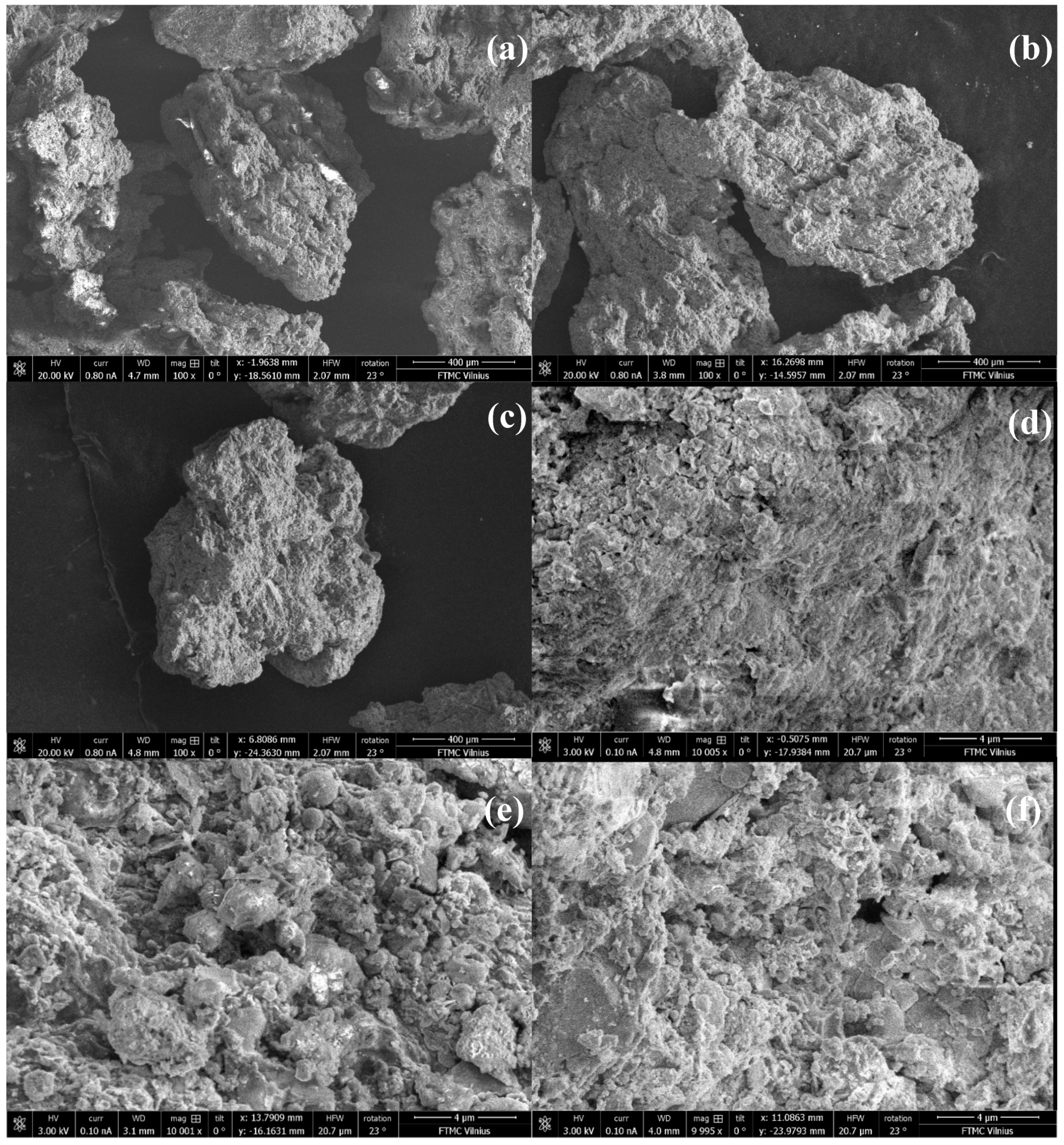
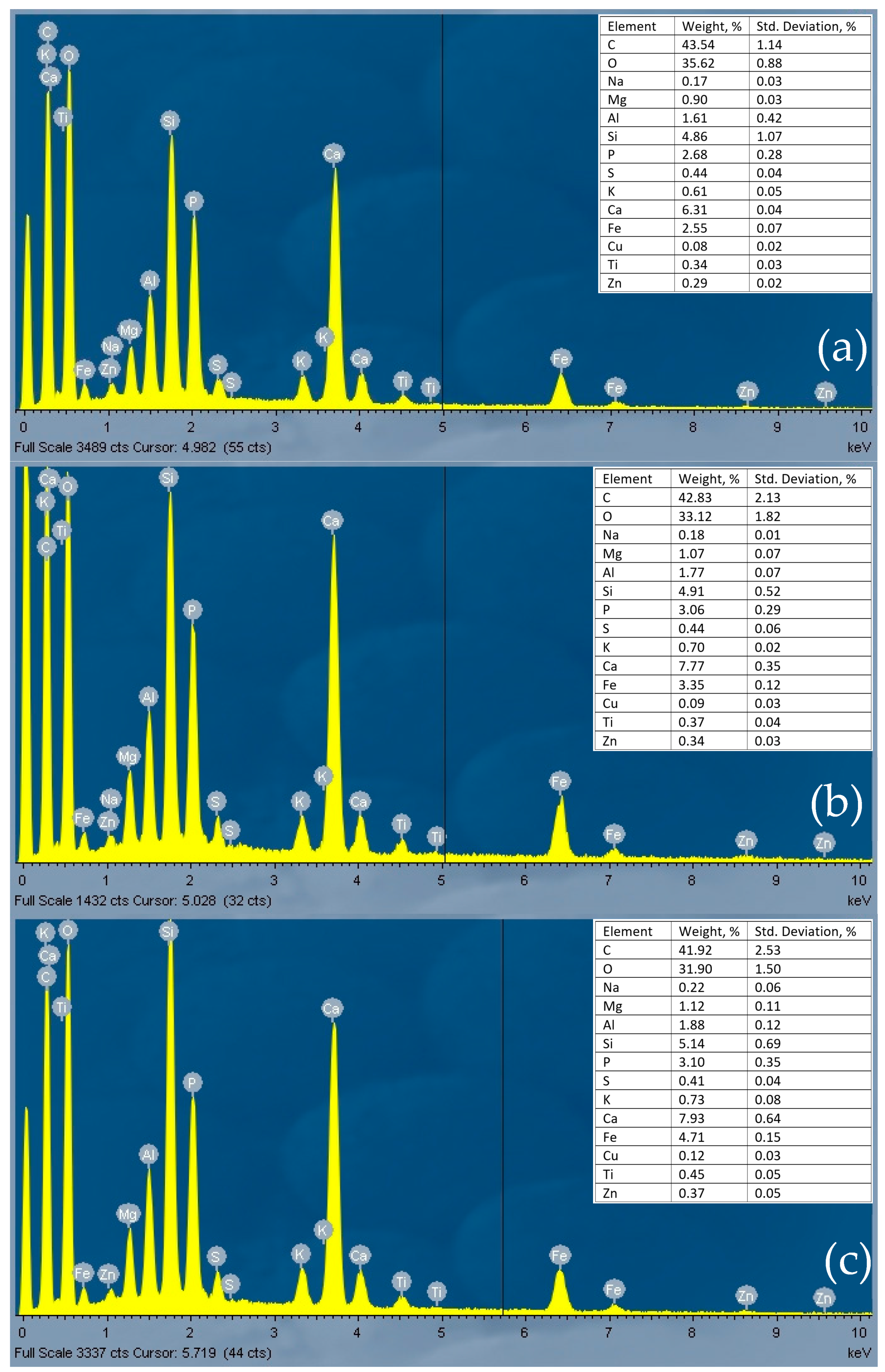

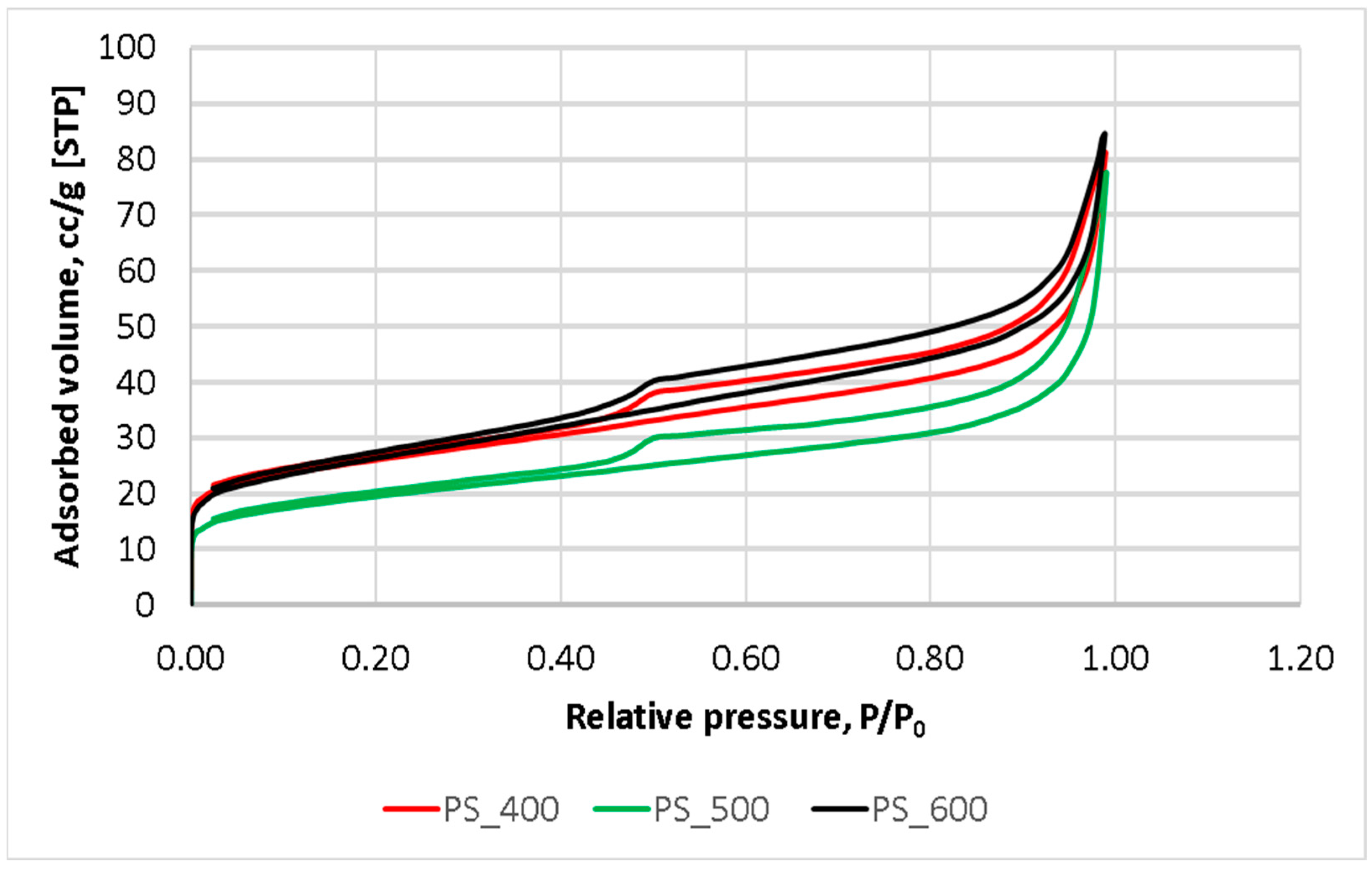
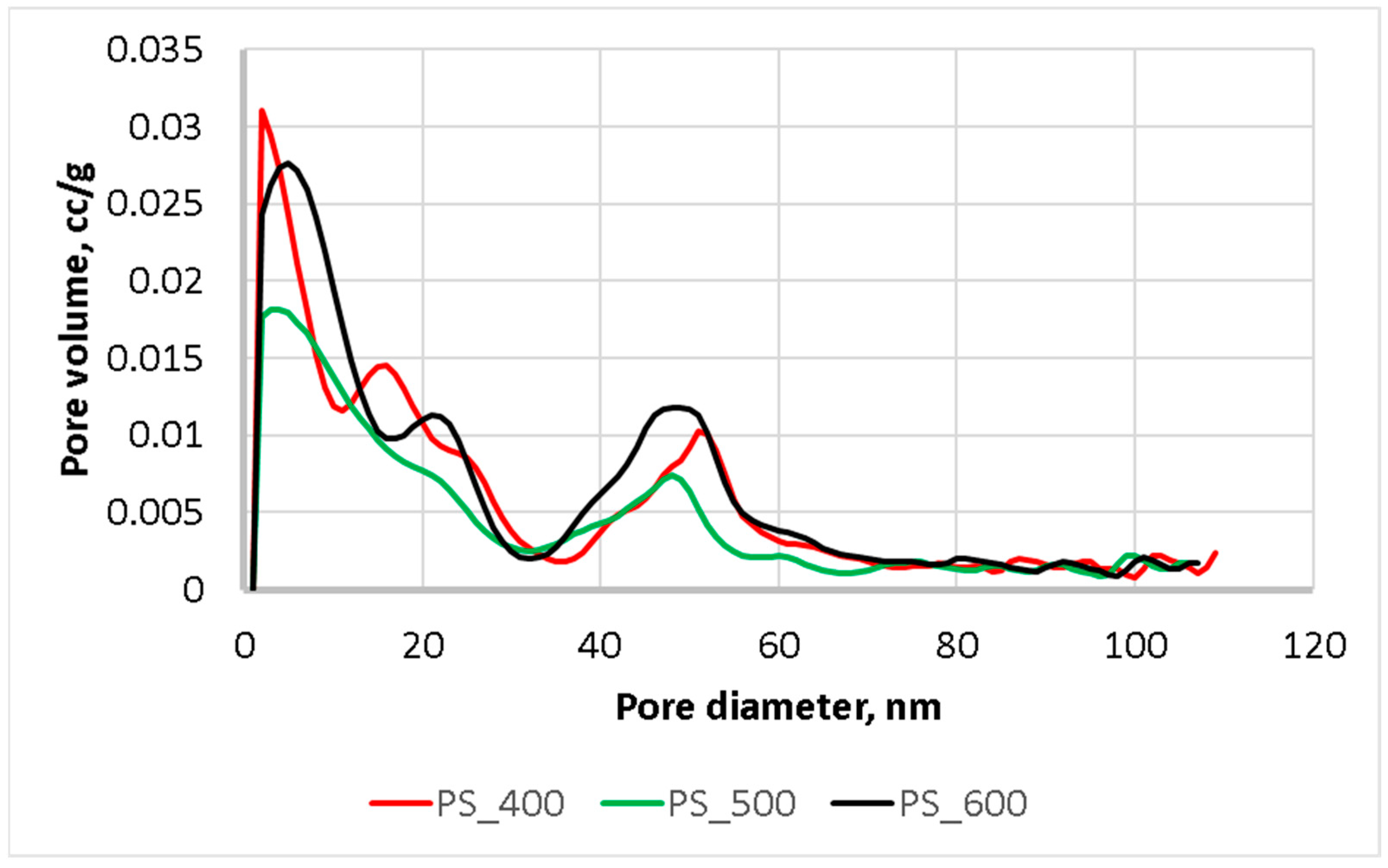

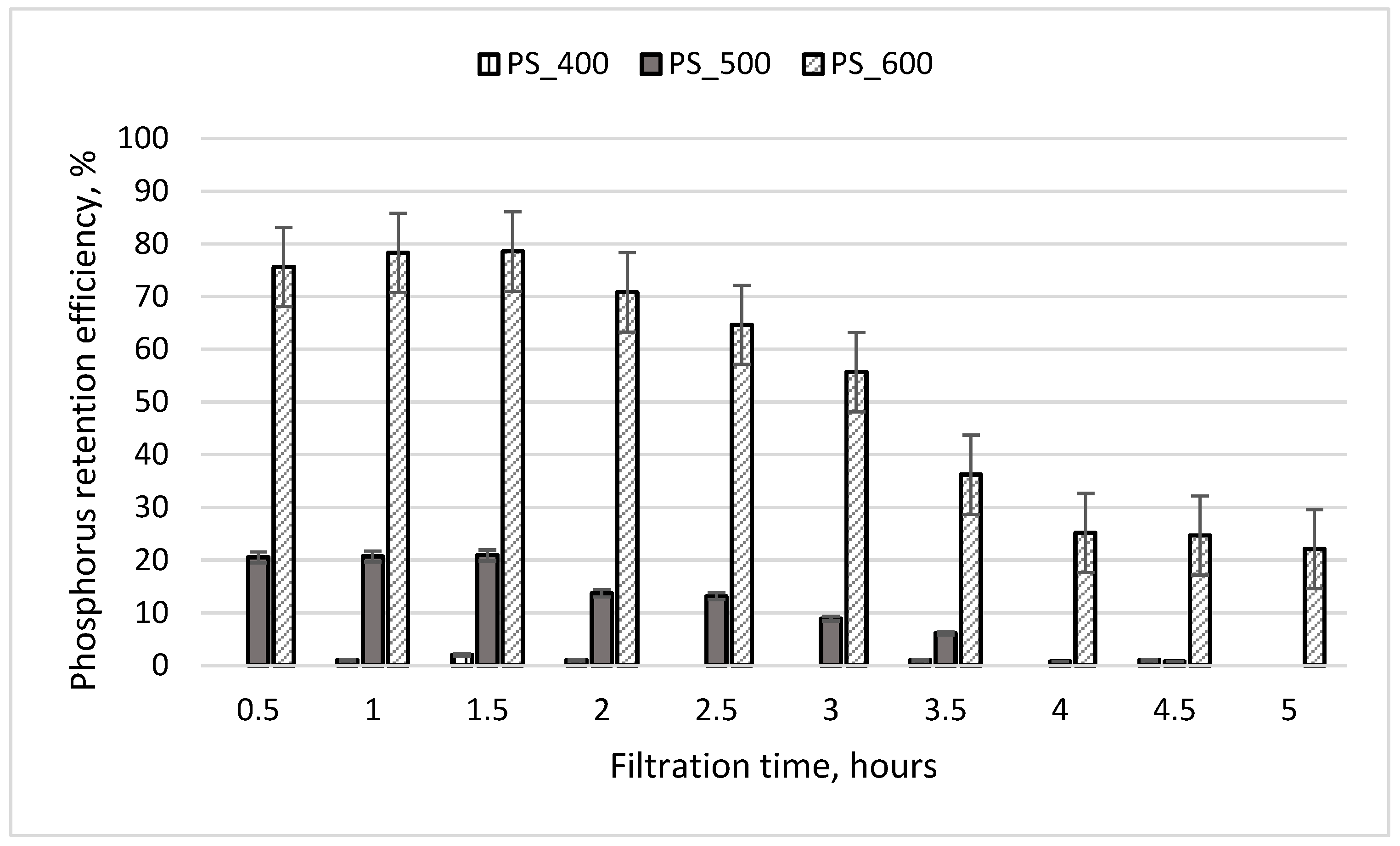
| Indicator | COD (mg/L) | BOD7 (mg/L) | SS (mg/L) | NO3-N (mg/L) | NH4-N (mg/L) | PO4-P (mg/L) | pH |
|---|---|---|---|---|---|---|---|
| Experiment No. 1 | |||||||
| Value | 41 | 9.6 | 10.1 | 5.53 | 10.64 | 1.38 | 7.5 |
| Experiment No. 2 | |||||||
| Value | 39 | 7.5 | 8.6 | 9.45 | 8.33 | 3.93 | 7.6 |
| Column No. | Pyrolysis Temperature, °C | Fraction, mm | Volume, mL | Column Height, cm | Mass, g | Apparent Density, (g/cm3) |
|---|---|---|---|---|---|---|
| Experiment No. 1 | ||||||
| 1 | 400 | 1.0–1.6 | 400 | 27.2 | 208 | 0.520 |
| 2 | 500 | 1.0–1.6 | 400 | 27.2 | 211 | 0.528 |
| 3 | 600 | 1.0–1.6 | 400 | 27.2 | 209 | 0.523 |
| Experiment No. 2 | ||||||
| 1 | 400 | 0.6–1.0 | 200 | 13.6 | 130 | 0.650 |
| 2 | 500 | 0.6–1.0 | 200 | 13.6 | 131 | 0.645 |
| 3 | 600 | 0.6–1.0 | 200 | 13.6 | 128 | 0.639 |
| Sample Code | SBET, m2/g | Smic, m2/g | Sext, m2/g | Vpore, mL/g | APS, nm | ε |
|---|---|---|---|---|---|---|
| PS_400 (2) | 127.589 | 94.2 | 33.389 | 0.090 | 5.39 | 0.979 |
| PS_500 (3) | 82.669 | 54.7 | 27.969 | 0.074 | 6.92 | 0.975 |
| PS_600 (4) | 107.994 | 67.3 | 40.694 | 0.095 | 5.60 | 0.980 |
Disclaimer/Publisher’s Note: The statements, opinions and data contained in all publications are solely those of the individual author(s) and contributor(s) and not of MDPI and/or the editor(s). MDPI and/or the editor(s) disclaim responsibility for any injury to people or property resulting from any ideas, methods, instructions or products referred to in the content. |
© 2024 by the authors. Licensee MDPI, Basel, Switzerland. This article is an open access article distributed under the terms and conditions of the Creative Commons Attribution (CC BY) license (https://creativecommons.org/licenses/by/4.0/).
Share and Cite
Januševičius, T.; Mažeikienė, A.; Stepova, K.; Danila, V.; Paliulis, D. The Removal of Phosphorus from Wastewater Using a Sewage Sludge Biochar: A Column Study. Water 2024, 16, 1104. https://doi.org/10.3390/w16081104
Januševičius T, Mažeikienė A, Stepova K, Danila V, Paliulis D. The Removal of Phosphorus from Wastewater Using a Sewage Sludge Biochar: A Column Study. Water. 2024; 16(8):1104. https://doi.org/10.3390/w16081104
Chicago/Turabian StyleJanuševičius, Tomas, Aušra Mažeikienė, Kateryna Stepova, Vaidotas Danila, and Dainius Paliulis. 2024. "The Removal of Phosphorus from Wastewater Using a Sewage Sludge Biochar: A Column Study" Water 16, no. 8: 1104. https://doi.org/10.3390/w16081104
APA StyleJanuševičius, T., Mažeikienė, A., Stepova, K., Danila, V., & Paliulis, D. (2024). The Removal of Phosphorus from Wastewater Using a Sewage Sludge Biochar: A Column Study. Water, 16(8), 1104. https://doi.org/10.3390/w16081104







